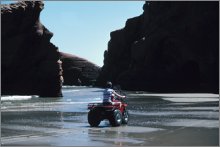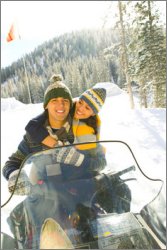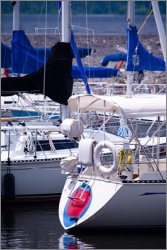|
|

|

ATV, Snowmobile and Other Motorized Recreation Accidents are On the Rise: The Numbers and Essential Safety Tips
by www.SixWise.com Millions of Americans love the thrill of speeding down a snow-covered trail on a snowmobile, seeing the back-roads on an all-terrain vehicle (ATV) or taking in the sun and scenery on a motorboat. But these favorite pastimes have a downside: they can be deadly if you don't take the right safety precautions.
Recreation Accidents on the Rise
What are the facts when it comes to accidents and injuries associated with popular motorized hobbies?
-
According to the Consumer Product Safety Commission's (CPSC) annual report on ATV deaths and injuries, 555 people died in ATV accidents in 2006, including more than 100 children. Another 146,000 were treated for ATV-related injuries.
-
About 110 people die each year while riding snowmobiles, according to CPSC, and another 13,400 visit a hospital emergency room because of snowmobile-related injuries. About 40 percent of the reported deaths result from colliding with trees, wires, bridges, and other vehicles.
-
There were 710 boating deaths in 2006, along with 3,474 injuries and over $43.6 million in property damage, according to the U.S. Coast Guard.
Enjoying Your Hobby: Key Tips for Staying Safe
No one wants their long-awaited leisure time to be interrupted by an injury, or worse. You can continue to enjoy the hobby you love, while keeping yourself and your family safe, with these essential tips.
|

Always wear a helmet when riding an ATV, and make sure children are riding on a youth-sized model. |
ATV Safety Essentials
-
Take a safety-training course. This will teach you how to control the ATV, and, according to CPSC, those who had formal, hands-on ATV training have a lower risk of injury than those who did not.
-
Wear the correct gear. This means a helmet (many ATV injuries are head injuries), over-the-ankle boots, goggles, gloves, long pants and a long-sleeved shirt.
-
Don't carry a passenger. Most ATVs are designed for one person only.
-
Don't allow children to ride on adult-sized ATVs. Keep in mind that most injuries and deaths involving children occurred because a child drove or rode on an adult ATV. Children under 16 should ride youth-sized ATVs.
-
Don't drive on paved roads. ATVs are difficult to control on smooth pavement.
-
Don't drink and drive. Just as when driving your regular vehicle, you should not drink and drive an ATV.
|

Always snowmobile with a buddy so there's someone to go for help in case of an emergency. |
Snomobile Safety Essentials
-
Drive only on established and marked trails, or in specified use areas.
-
Never ride a snowmobile alone or on unfamiliar ground.
-
Keep a lookout for obstacles, such as rocks, trees, fences, ditches and more.
-
Slow down when you come to the top of a hill (you don't know what's on the other side).
-
Don't hurdle snowbanks, as it's easy to lose control.
-
Use caution when driving at night, and don't drive faster than your headlights will allow you to see.
-
Avoid driving on frozen ponds, as the ice may give way.
-
Don't drink and drive.
Boating Safety Essentials
|

Avoid the temptation to drink while you boat. Alcohol is the leading contributing factor in fatal boating accidents. |
-
Take a boating safety instruction course. In 2006, 70 percent of fatalities occurred on boats where the operator had not received such instruction.
-
Wear a life jacket. Two-thirds of the 2006 fatal boating accident victims drowned. Among them, 90 percent were not wearing a life jacket.
-
Don't drink and drive a boat. Alcohol is the leading contributing factor in fatal boating accidents, according to the U.S. Coast Guard.
-
Install and maintain carbon monoxide detectors on your boat. Twelve people died of carbon monoxide poisoning on a boat in 2006.
-
Get a free Vessel Safety Check (VSC) every year. This can spot potentially dangerous mechanical problems that you may overlook. To find a VSC examiner near you, visit VesselSafetyCheck.org.
Recommended Reading
The Top 5 Causes of Head Injuries and How to Avoid Them
Automobile Back-Over Accidents: How to Avoid a Surprisingly Prevalent & Serious Accident
U.S. CPSC Snowmobile Hazards
U.S. Coast Guard Boating Safety
To get more information about this and other highly important topics, sign up for your free subscription to our weekly SixWise.com "Be Safe, Live Long & Prosper" e-newsletter.
With every issue of the free SixWise.com newsletter, you’ll get access to the insights, products, services, and more that can truly improve your well-being, peace of mind, and therefore your life!
|
|
|
|